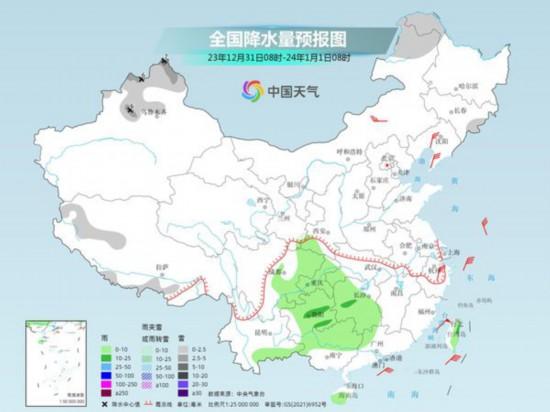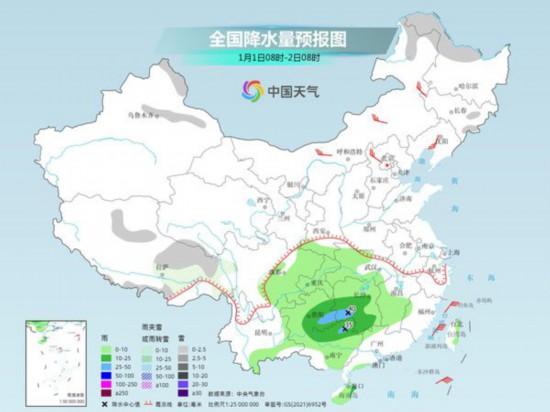China Weather Network News Today and tomorrow (December 31, 2023 to January 1, 2024), the snowfall in northern Xinjiang is still frequent, and the rainfall in the south will gradually increase, with the rainfall being mainly small to moderate. Affected by cold air, there will be a temperature drop of 4~6℃ in parts of the central and eastern regions, accompanied by windy weather.
Snowfall is still frequent in Xinjiang and other places, and rainfall in the south is gradually increasing.
Affected by the eastward movement of the high-altitude trough and the low-level vortex, snowfall occurred in Xinjiang, central and eastern Inner Mongolia and the northeast yesterday, including small to medium snow or sleet in northern Xinjiang, southern Heilongjiang, Jilin and Liaoning, and heavy snow in parts of eastern Liaoning.
It is estimated that two days after the New Year’s Day holiday, snowfall in northern Xinjiang and other places is still frequent, and the accumulated snowfall in parts of Tacheng and Altay is relatively large; Rainfall in the south will also gradually increase, with small to moderate rainfall as the main factor.
The Central Meteorological Observatory predicts that today, there will be small to medium snow or sleet in parts of northeastern Inner Mongolia, northwestern Heilongjiang and northern Xinjiang, among which there will be heavy snow (5 ~ 7 mm) in northern Xinjiang. There are small to moderate rains in parts of the eastern and southern Sichuan Basin, most of Guizhou, southern Yunnan, most of Hunan, and central and northern Guangxi.

Tomorrow, there will be small to medium snow or sleet in parts of northeastern Inner Mongolia, northwestern Heilongjiang, eastern northern Xinjiang, along the Tianshan Mountains and eastern Tibet. There are small to moderate rains in parts of central and western Jianghan, central and western Jiangnan, eastern Southwest and central and western South China. Among them, there are heavy rains (25-40 mm) in southwestern Hunan, southeastern Guizhou and northeastern Guangxi.

At present, there is still deep snow in Xinjiang and Northeast China, and the weather conditions are generally suitable for ice and snow activities. Everyone should pay attention to prevent the adverse effects of slippery roads, snow and ice on traffic.
Cold air continues to affect the central, eastern, northeastern, Jiangnan and other places, and the temperature drop can exceed 8 C.
Yesterday, the fog and haze weather in central and southern North China to the middle and lower reaches of the Yangtze River and Sichuan Basin continued, and the visibility in Tianjin, Hebei, Shandong, Henan and Jiangsu was poor. In the afternoon, due to the influence of cold air, the strongest fog and haze weather in North China, Huanghuai and other places this winter gradually weakened and dissipated from west to east and from north to south.
In addition to dispelling fog and haze, cold air will also bring temperature fluctuations to the central and eastern regions. Yesterday, the northern and northeastern parts of North China took the lead in cooling down. The monitoring shows that at 5 o’clock today, compared with 5 o’clock yesterday, some areas in central and eastern Inner Mongolia, western Jilin, central and western Liaoning, northwestern Shanxi and other places experienced a temperature drop of 6 ~ 8 C, and the local drop exceeded 10 C.
Today and tomorrow, cold air will continue to affect the central and eastern regions. It is estimated that the temperature in some parts of central and eastern China will drop by 4 ~ 6 C, and in some parts of the eastern part of Northeast China and the eastern part of the south of the Yangtze River will drop by more than 8 C, accompanied by northerly winds of about 4, and gusts in some parts of the north will be 6 ~ 7. There are more travel activities during the New Year holiday, so everyone needs to pay attention to the temperature change and take measures to prevent cold and keep warm.
In addition to this cold air during the New Year’s Day holiday, there will be two weak cold air activities in the northern region from January 2 to 3 and from January 4 to 5, 2024. On the whole, although there will be frequent cold air activities in the coming week, the overall intensity will be weak and the cooling time will be short, and the temperature in most parts of the country will remain at a higher level than normal.
Source: China Weather Network
Reporting/feedback